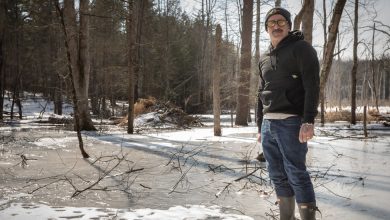Echinacea Isn’t Itself Anymore – The New York Times

[ad_1]
Even to someone intimately acquainted with the genus Echinacea, many of the latest coneflowers elicit a double take. Some are nearly unrecognizable; others represent a dramatic divergence from those that nature made.
It is the wild ones that Kelly Kindscher, an ethnobotanist and professor of environmental studies at the University of Kansas, has made the central theme of a career focused on prairie plant communities.
“It’s truly an iconic American genus,” Dr. Kindscher said of Echinacea, which many taxonomists count as including seven naturally occurring species, although some acknowledge as many as 10. Only one, Echinacea angustifolia — the westernmost species that he calls “the most important medicinal plant of the prairie,” used for hundreds of years by Native Americans — is found outside the continental United States, in a small part of the Canadian plains.
Some of the most recent cultivars are ornamental, Dr. Kindscher agrees, with their unexpected sunset colors or fluffy double flowers. He gets it: He may be a senior scientist with the Kansas Biological Survey, but he is also a keen gardener himself.
But you have to wonder what the pollinators that evolved alongside unadulterated native coneflowers — “tough prairie plants adapted for life among grasses,” as Dr. Kindscher described them — think of these startlingly different versions.
What do insects make of the coneflowers whose prominent cones of tiny, fertile disc florets — an easy landing pad for their pollen-collecting visits — have been all but obscured by what look like pom-poms? In these double flowers, derived from a chance mutation first observed in a cut-flower field in the Netherlands in 1997, the reproductive structure has been replaced by something resembling a petal. And so the ecological services the flower can offer are reduced, with less pollen, less nectar and usually fewer seeds.
The cone that forms the center of each flower, and is the prefix of the plants’ common name, was there for another reason, too, Dr. Kindscher said. The spiny structure was meant to deter predators’ grazing. (The Latin name Echinacea, which derives from the same Greek word as hedgehog and sea urchin, hints at that function.)
Even the familiar Echinacea that you see growing in nursery pots — the basic E. purpurea, or purple coneflower — isn’t quite itself anymore. It has undergone subtler changes than those dramatic double flowers, but the store-bought purpurea has broader petals than nature’s version, a trend that began in the 1960s when a German breeder began making selections in favor of that trait. In the wild form, what we regard as the petals (technically, the ray florets) are narrower and longer.
So before you shop, you have a decision to make: Are you planting a pollinator garden or do you just want some high-summer bloom for visual consumption?
Mt. Cuba Center, the native-plant garden and research facility in Delaware, has some advice before you go all doubles-crazy, which a recent report from the organization described as “a trade-off for style over substance.” Choose well, and you can have both.
Echinacea Put to the Test
Mt. Cuba completed a second multiyear study of Echinacea in 2020, comparing the many species and cultivars — a total of 75 coneflowers, said Sam Hoadley, the trial garden manager who led the research.
From 2007 to 2009, the center had studied 48 types of coneflowers. But with their growing popularity and the profusion of new cultivars — sometimes referred to as nativars, for cultivars of native plants — it seemed time to revisit them, he said. And the latest trial was designed to include a feature that had not been on the radar the first time: a pollinator survey, or a tally of insect visitation performed by a team of citizen scientists, with special attention paid to the difference between single and double flowers, and their appeal to bees, wasps and butterflies.
Some of the new Echinacea varieties are selections — meaning that a population of seedlings was observed and the best of the lot brought forward. Others are hybrids resulting from one species being intentionally crossed with another. That’s something that Echinacea plants are also happy to do by themselves, apparently.
“I think if we had grown out all the seedlings we weeded out from our trials we would have had quite the kaleidoscope of plants,” Mr. Hoadley said.
“It’s a promiscuous species,” Dr. Kindscher said, “and we even see hybrids in the wild.”
So far, he has not seen hybridization between cultivars and wild plants, but the concern has been raised, and researchers are on the lookout.
An insight for gardeners who see an unusual-looking plant emerge in or near a spot where one was growing before: “When people say, ‘My Echinacea has reverted,’” Mr. Hoadley said, “what has happened is that seedlings have germinated beside a parent. It’s not a reversion.”
One species, in particular, has proved irresistible to breeders, inviting the development of novel-colored coneflowers, beginning in the 1990s: The canary-yellow Echinacea paradoxa, with a native range centered in the Ozarks.
The epithet “paradoxa” is telltale, as this coneflower is a paradox in a genus whose palette is typically limited to purples and pinks. With yellow added to the gene pool, red and orange coneflowers became possible.
And the Winner Is …
Not all coneflowers are as easy to grow or as adaptable as E. purpurea, a plant native to open woodlands throughout the Eastern United States. Its leaves are broader than those of other species, which gives away its habitat of origin, indicating that it has enough leaf surface to do the job of photosynthesis, even in lower light conditions.
So it’s no surprise that selections and cultivars that were at least partially derived from E. purpurea generally did the best in the Mt. Cuba trials. Many of this coneflower’s cousins are taprooted, designed for pushing down into dry, thin soil for moisture and penetrating crevices in fractured rock. The taprooted E. angustifolia, for instance, “likes the Great Plains climate and tends to die out in Eastern and English gardens,” Dr. Kindscher said. But E. purpurea has fibrous roots that are more forgiving, even when it’s transplanted.
“Many of the top-performing cultivars originated from purpurea,” Mr. Hoadley said, “and some of the best are the ones created by selections — without a lot of human influence.”
Newer Isn’t Always Better
What struck Mr. Hoadley most of all: A couple of the stars of the 2007-2009 trial remained the greatest hits more than a decade later.
The traditionally colored Pica Bella, a compact variety with prominent orange cones that are a magnet for pollinators, was “our absolute top performer,” he said. In the quest to patent new traits and varieties, it seems, excellent older plants like this one sometimes get left behind.
“Ask your nursery for it,” Mr. Hoadley said. “Hopefully, consumer demand will help bring it back to wider supply.” (Specialty mail-order suppliers like Digging Dog Nursery and Broken Arrow Nursery offer it some seasons.)
The white-flowered Fragrant Angel, also a purpurea, averaged by far the most butterfly visits of any plant in the trial, and was a hit with bees and wasps, too. Butterflies generally amount to maybe 5 percent of a coneflower’s insect visits, but this one rated 14 percent.
Another highly rated white variety was Snow Cone, a compact plant with the species Echinacea tennesseensis in its parentage.
Among the top-performing hot-colored cultivars were the coral Santa Fe, Postman and the Intense Orange offering in the Kismet series — much more vigorous than early introductions in this color range, which often proved short-lived.
Echinacea pallida would have liked a drier, less rich soil than the trial garden offered, Mr. Hoadley acknowledged, but its dramatically long, drooping petals attracted his attention.
Dr. Kindscher, too, questioned why it isn’t more widely grown. “I don’t know what breeders are working on, but an orange or red nativar of pallida with long, droopy petals sounds like a good one,” he said.
And unsurprisingly: No double-flowered form that was trialed rated even an honorable mention.
Powerful Plants
It was the medicinal power of Echinacea, learned about from Native Americans, that got European settlers interested in the plant. Each tribe had its own word for coneflower, and the translations differed, too, Dr. Kindscher writes in his 2016 book, “Echinacea: Herbal Medicine With a Wild History.”
The translations ranged from “medicine makes you numb” (Kiowa Apache) to “cold medicine” (Hidatsa) and “something used to knock something down” (Lakota).
The first plants were sent back to England in the late 17th century. Gradually, coneflowers made their way into gardens both physic and ornamental, marking the long-ago roots of their now fast-evolving history in modern horticulture.
The same bioactive compounds that made the species E. angustifolia the most widely used medicinal plant of the Plains tribes, Dr. Kindscher said, served as protection against insects. Like the spiny cone, their chemistry is a defense against predation.
And speaking of that spiny cone: It’s not just Dr. Kindscher, Mr. Hoadley and the pollinators who are in favor of keeping it intact and hedgehog-like. American goldfinches, who love a good meal of coneflower seeds, resoundingly agree.
Margaret Roach is the creator of the website and podcast A Way to Garden, and a book of the same name.
For weekly email updates on residential real estate news, sign up here. Follow us on Twitter: @nytrealestate.
[ad_2]
Source link






